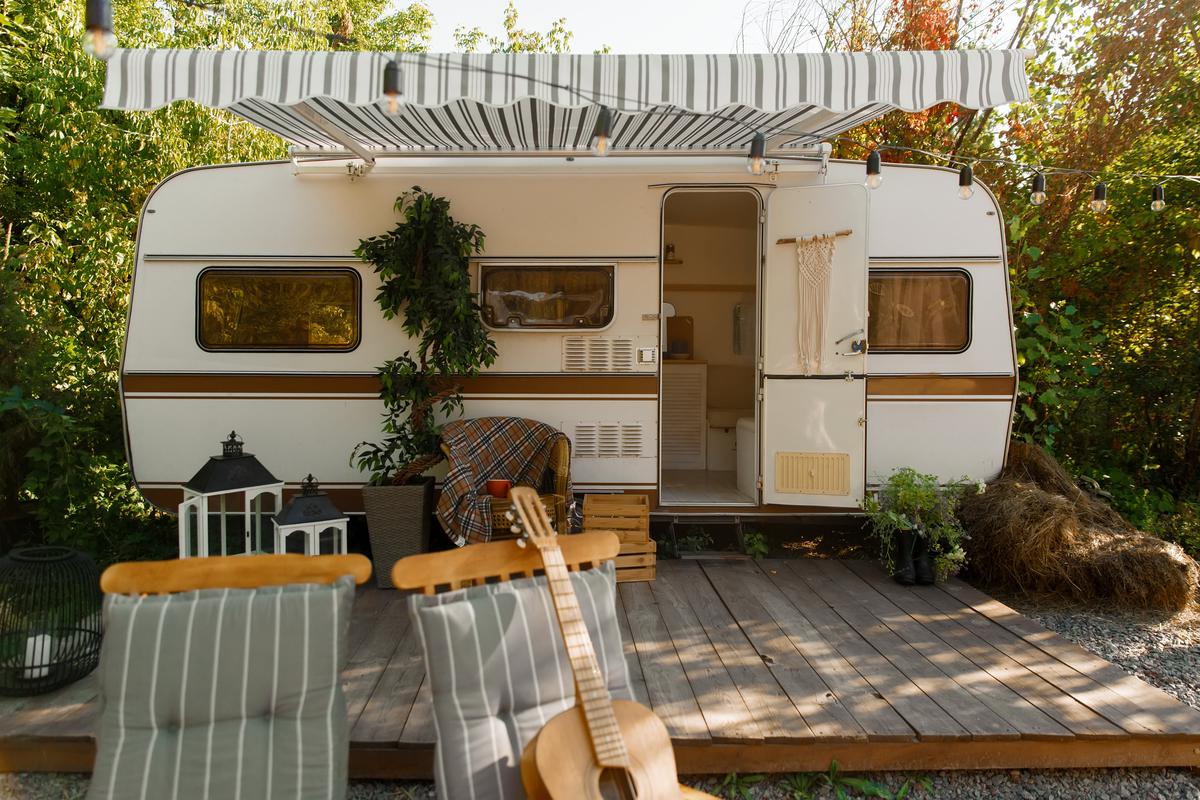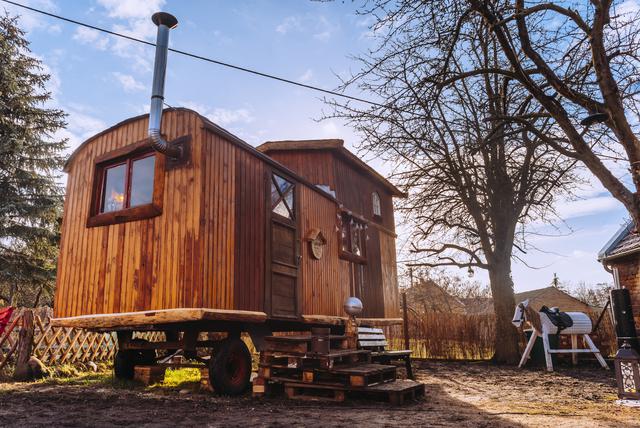At first glance, RVs and tiny homes on wheels seem to be the same. They both feature a homey interior with all the basic amenities that make it a livable space — and they’re both on wheels. The two fundamentally share the same purpose of offering an adventurous lifestyle with efficiency, minimalism, and low maintenance in mind. Upon closer inspection, however, you will notice quite a few differences between the two. These differences mainly have to do with structure, functionality, and cost, among other factors. While both are essentially structures built on wheels, the similarities mainly end there.

What Is a Recreational Vehicle Used For?
The media often portrays RVs as small driveable houses in which families travel from one state to another. The term itself is an abbreviation for ‘recreational vehicle’ as it is mainly used for recreational purposes such as camping or going on cross-country road trips. It is essentially a vehicle that features a living quarter capable of accommodating a small group of people.
What Is a Tiny Home on Wheels?

What is a Tiny Home on Wheels?
A tiny home on wheels, or THOW for short, doesn’t really have a specific definition. Generally speaking, it is built to be a home — only downsized. Although it is on wheels, the “tiny home” is not meant for consistent traveling. Its wheels simply serve as a loophole for builders to avoid regulations that dictate the minimum home size. This means that a THOW can technically be qualified as an RV which you can customize to a less-regulated standard.
Differences Between an RV and a Tiny Home on Wheels
What Are They Built for?

General Differences Between an RV and a Tiny Home on Wheels
The main difference between a recreational vehicle and a tiny home on wheels is that the former is built to be on the road. An RV features light and aerodynamic building materials in addition to water and electricity hookups, making it ideal for travel.
Despite a THOW’s mobility, its structure can be compromised by excessive movement. It often features hookups for municipal electric and plumbing systems. In other words, you can’t pull up to a campsite and set the utilities up as you can with an RV. Even the electrical systems are different. A standard recreational vehicle requires 12V power for most of its appliances and electronics. Tiny homes on wheels, however, sometimes make use of household appliances that need a constant supply of power.
Construction and Materials
In terms of construction and materials, a tiny home on wheels is ‘huge’ on customization. You can, in most cases, fully customize it to fit your needs — which is great if you plan on using eco-friendly materials and greener energy sources. Being a stationary structure, a THOW’s materials are typically stronger, heavier, and more stable than those of a recreational vehicle. This also makes it the more weather-proof option.
RVs, on the other hand, are always set to be on the go. Since it normally consists of lightweight materials, you can drive an RV — or tow it — as fast as most other vehicles. Due to mass production, recreational vehicles are cost-effective, efficient to build, and easy to obtain. Although they don’t have the customizability of tiny homes on wheels, RVs are known to be incredibly practical and sophisticated.
Chassis, Axles, and Wheels
In the case of an RV, there’s not much to worry about regarding the actual chassis. The manufacturers often guarantee that the chassis fully supports the weight of the structure. A tiny house on wheels, on the other hand, is a different story considering the number of people who take the construction into their own hands.
In most cases, tiny homes on wheels will feature a simple flat-bed trailer. This option is commonly available to buy either new or previously owned. Although a double-axle trailer is more preferable, the most important factor is the THOW’s intended size — a key element that determines how big the trailer should be and how much the axle can hold. Each axle can normally support 3000 to 7000 lbs (which means a 6000 to 14000 lbs towing capacity).
Furniture and Appliances

Warming Up to RV and THOW Interiors
Since every inch of space counts, tiny homes on wheels will often have scaled-down versions of residential appliances. These may include mini-fridges as well as cooktops minus the oven range. Homeowners will also need to determine which appliances they need and which they can forgo. For instance, you can probably do without dishwashers, washer/dryer combos, and maybe microwaves. Bear in mind that minimalism is key in a tiny house on wheels, and this includes the number of dishes and clothes you’ll need to wash. The same concept applies to recreational vehicles — why would you need a dishwasher when you’re going camping?
As for furniture, creativity is the way to go. Many of the features in a tiny house of wheels have dual-functionality and can be tucked away or built-in.
Layouts and Floor Plans
As far as imagination goes, there’s a variety of layouts and floor plans for a tiny house on wheels. Besides the options provided by THOW builders, you can find a myriad of free resources for pre-designed plans. You can even design your own to accommodate certain ideas or limitations. As for RVs, the vehicles often come with their own layouts. But what they lack in customizability, they make up for with creativity and innovation. RV manufacturers have been using feedback from customers to fine-tune and develop their products.
Manufacturing Versus DIY

Can You DIY a Tiny Home on Wheels?
Despite being a relatively new concept, the trend of tiny living has grown enough to pave the way for the emergence of more and more THOW manufacturers. And because the tiny houses are on wheels, you can order one from practically anywhere in the country and it will be delivered to you. Many, however, may choose to DIY their tiny home on wheels either to cut costs, to implement their own concept, or simply because of a passion to build with their own hands.
Cost of RVs Versus Mobile Homes
The price range for tiny homes with wheels is quite wide. Depending on your budget and specific needs, you can expect to pay anywhere between $10,000 and $150,000 — with an average of $60,000. While the higher end will get you the premium package, the lower end may involve some DIY work.
Recreational vehicles have an even wider range of prices. Since they are more common, it’s quite likely that you may find a good deal on a previously owned RV. If you’re looking for a deluxe RV with all the amenities one can hope for, be prepared to splurge up to $300,000. On the lower end of the spectrum, a $35,000 RV can be more than enough for road trips.
Size of RVs vs Tiny Homes on Wheels

RVs Are Generally Larger Than Mobile Homes
RVs are generally bigger than tiny homes on wheels. Although the customizability of a house with wheels allows for a wide variety of sizes, most of them range between 100 to 400 square feet. Unless you hold a commercial driver’s license, the maximum dimensions allowed for a trailer are 8.5 feet in width, 13.5 feet in height, and 40 feet in length. Most mobile homes, however, are only 20 feet long on average. Although RVs have the same size restrictions, many of them feature expandable slide-outs that, once parked, stretch the width and square footage.
Which Can You Take Camping?

Recreational Vehicles Are Ideal for Camping Purposes
Although you technically can take a mobile home camping, it’s probably not very well suited for that purpose. Finding a place to park your THOW can be rather tricky to start with. Also, it doesn’t use utilities like an RV and it’s not allowed in certain campgrounds. Unless you’re camping for extended periods of time, it’s not worth the effort. RVs, on the other hand, is practically designed for comfortable camping.
Full-Time Living
Tiny homes on wheels can be ideal for full-time living, as long you’re staying in one place. You may need to account for a couple of factors if you plan on living in an RV or a mobile home. While there are certain regulations regarding where and how you may park your tiny house on wheels, an RV usually doesn’t have that issue. Recreational vehicles are also easier to insure.
As for comfort, it mainly depends on your budget and whether you prefer moving around or staying put. In the latter case, a tiny home on wheels may also offer more weather protection whereas an RV is more suitable for adventurers.
you may also like


comments